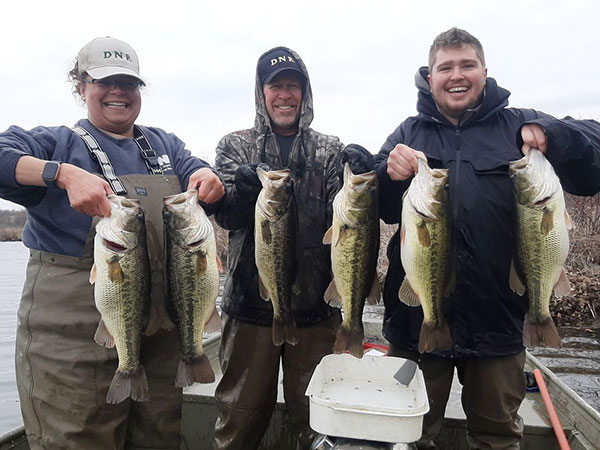By Louie Stout
 Indiana fish biologists with Hamilton Lake Bass
Indiana fish biologists with Hamilton Lake Bass
A crappie and northern pike survey at Hamilton Lake coincidentally revealed better news about bass and bluegill.
Indiana fish biologists surveyed the popular northeast Indiana lake earlier this spring. The lake hadn’t been surveyed since 2004 so fish managers wanted to evaluate the crappie and pike while they were still shallow.
The lake historically has had a big population of slow growing and stunted pike so the DNR instituted regulations for the lake a few years ago that removed the size limit (24 inches statewide). You can keep five, but only one 30 inches and over.
It must be working. Biologists captured 50 percent fewer this year than they did in 2008. The also saw fish up to 36 inches which was bigger than they saw the last time.
“The average size of the females was bigger so we might be seeing a change,” said District Biologist Matt Horsley. “It will take some time to see the bigger fish population develop, but overall, I was pleased.”
The crappie catch was disappointing. Horsley said Hamilton has been known as a phenomenal crappie fishery, but his crew had a tough time finding them.
“The size structure of those we did find was poor, he said. “Most were in that 6- to 8-inch mark. It could be a down year, or it could be a matter of timing and the fish were just starting to move in. But normally, we see a wide range of year classes.”
BLUEGILL
Previous biologists have complained that the lake lacked good numbers of quality bluegill, but Horsley findings were to the contrary.
Although the bluegill weren’t being targeted, his crew had one net with 3,000 to 4,000, many which were 7 to 8 inches.
“Same with redear,” said Horsley. “Really nice ones.”
BASS
Nor were the nets targeting bass, but they showed up in surprising numbers.
And big ones.
“We saw fish up to 6 pounds and several in that 5 to 6 pound class,” said Horsley.
The lake has been a popular tournament site and the incidental catch of bass proved why.
The DNR crew will return to the lake this month to take a closer look at the bass population and plans to do an overall survey of the lake in June.


